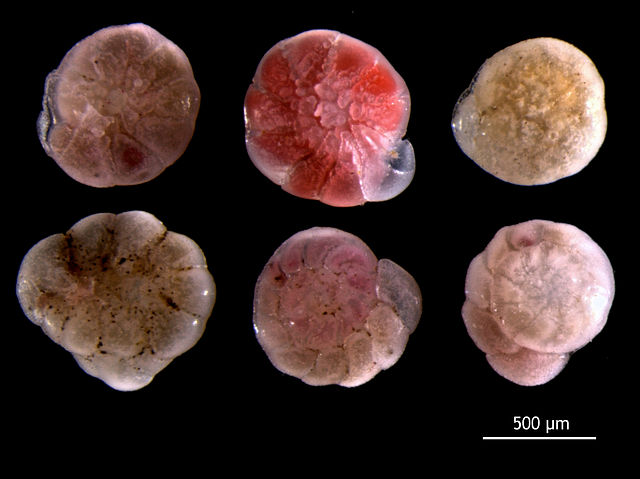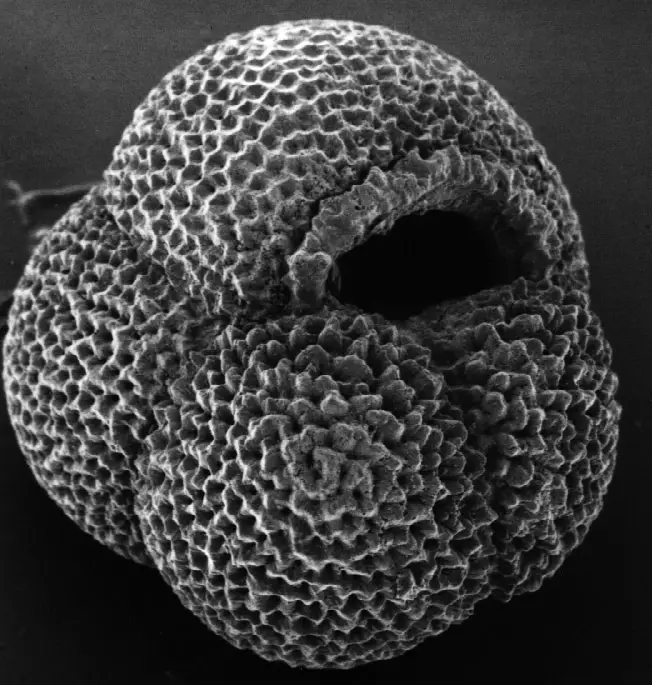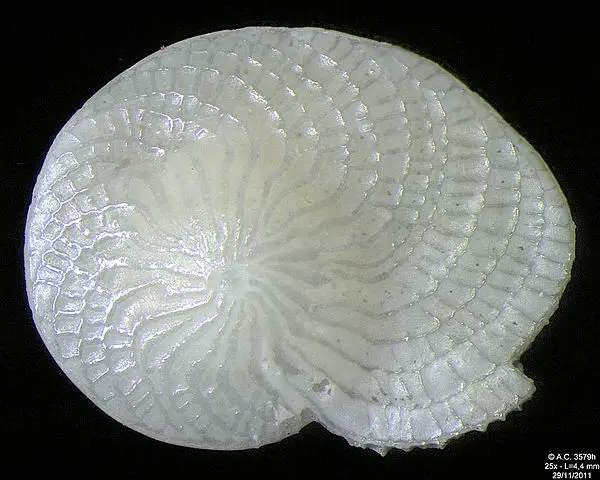Foraminifera Species
Classification, Habitat and Reproduction
Overview of the Foraminifera Species
First identified in the 5th Century, the Foraminifera species are single-celled protozoans commonly found in marine environments (some are much bigger in size). Despite being single-celled, microscopic organisms, Foraminifera species are characterized by the presence of shells known as tests.
Depending on their habitat, some of the species have been shown to form an association with algae/cyanobacteria for survival. However, the majority of species are free-living organisms that feed on a variety of food sources in their surroundings.
While they share many characteristics, Foraminifera species are divided into two major groups that include benthic species (found on the seafloor) and planktonic species (drifter).
As some of the most abundant organisms in marine environments, Foraminifera species play an important role in these ecologies (in the food web etc) and also provide important information regarding the age marine sediments as well as the overall environmental health of the ecosystem.
Some examples of Foraminifera species include:
- Globigerina bulloides
- Globigerinoides ruber
- Globorotalia inflata
- Globigerinoides sacculifer
- Globorotalia menardii
- Neogloboquadrina pachyderma
* The word Foraminifera is derived from Latin word "Foramen" that means hole-bearing.
Brief History of Foraminifera in Scientific Literature
In the 5th Century BC, Herodotus discovered Nummulities in rocks used to construct Egyptian pyramids.
In 1558 A.D., Agricola recognized these Nummulities as fossil remains of living organisms.
1700 - Antonie van Leeuwenhoek observed the shells of Foraminifera under the microscope, noting that they were no bigger than a grain of sand.
In 1731, Beccarius described smaller species of Foraminifera.
In 1835, Dujardin discovered and demonstrated the protozoan nature of Foraminifera.
In 1839, d'Orbigny established a foundation for the study of Foraminifera which allowed and produced a system for their classification (5 families, 52 genera, 544 species).
General classification of Foraminifera (Based on Loeblich and Tappan (1964) approach)
Kingdom: Protista - The kingdom Protista consists of single-celled eukaryotes (as well as microscopic colonies) that can be found in aquatic environments, terrestrial habitats as well as in given hosts as parasites. As well, some of the species form symbiotic relationships with other organisms.
Subkingdom: Protozoa - Also ranked as a kingdom in some books, Protozoa consists of single-celled eukaryotes that may exist as free-living organisms or as parasites. They can be found in various moist or aquatic habitats across the world and feed on various organic materials, other microorganisms, debris, or organic tissues.
Phylum: Sarcomastigophora - Being a group under the Kingdom Protista, members of this Phylum are unicellular or colonial organisms that may either be autotrophic or heterotrophic in nature. Members of this group are characterized by such locomotory organs as flagella, pseudopodia, or both.
Subphylum: Sarcodina - Members of this subphylum may be described as protozoans that move using pseudopodia. They are single-celled and can be found in various habitats where they use their pseudopods for both feeding (capture and engulf food) and moving.
Superclass: Rhizopoda - Consists of members characterized by pseudopods (amoebas and foraminifers).
Class: Granuloreticulosea - Characterized by anastomosing pseudopodia that contributes to the formation of the outer shell.
Foraminifera Ecology
In marine environments, Foraminifera are either planktonic or benthic. Typically, Benthic Foraminifera are bottom dwellers and thus reside at the seafloor. Here, they can be found in such habitats as marshes and abyssal plains where they move about and feed using their pseudopodia. Currently, it's estimated that there are about 4,000 species that belong to this group.
Apart from the large population of benthic species found at the sea floor, studies have shown that some of the species reside in sediments, macroalgae, as well as rocks in marine environments.
While they are not as abundant as bacteria, they have been shown to be sufficiently abundant to be part of the marine food chain. For instance, in their environment, they serve as a food source for such organisms as isopods, small fish and marine snails, etc.
Examples of benthic Foraminifera include:
- Brizalina alata
- Bigenerina nodosaria
- Lagena striata
- Cyclamina acutidorsata
The other group of Foraminifera species found in marine environments are planktonic species (Planktic foraminifera). Unlike benthic Foraminifera, these species float in water columns at various ocean depths and are therefore referred to as drifters. Currently, about 40 planktonic species have been identified.
Like benthic species, planktonic Foraminifera also live freely in marine environments. Here, they use their pseudopods to trap and capture prey (e.g. copepods and phytoplankton etc). Some of the species have been shown to form symbiotic relationships with other organisms (e.g. algae).
Normally, symbiotic relationships are formed between the larger Foraminifera species (between 0.1 and 6 cm) and algae. In this relationship, the algae reside within the test/shell structure of the organism (endosymbiotic).
According to a number of studies, in addition to their large size that allows them to host the algae, these Foraminifera species have also been shown to have a complex internal structure that promotes this relationship.
Apart from algae (unicellular red algae), this symbiotic relationship may also be formed with red cyanobacteria, diatoms, chlorophytes, and dinoflagellates. While some species (larger ones) form symbiotic relationships with other organisms, it's worth noting that they still use their web-like pseudopodia to trap and capture food material.
Moreover, the inhabiting organisms (e.g. algae) are also separated from the digestive activities of the host (Foraminifera). As a result, researchers are yet to understand how Foraminifera exactly benefit from this relationship. However, some researchers suggest that they use the food material in the absence of other food sources.
* Benthic species are the earliest forms of Foraminifera.
* In the Tethys and epicontinental basins of Europe, fossil records of planktonic species have been traced back to the Mid Jurassic period.
* During their early stages of development, planktonic Foraminifera have been shown to live in the euphotic zone (closer to the water surface). However, they start descending to the deeper columns as they grow in size.
* Some Foraminifera species have been shown to be parasites of mollusks and other forams.
Some examples of planktonic (Planktic Foraminifera) species include:
- Heterohelix globulosa
- Hedbergella delrioensis
- Archaeoglobigerina cretacea
- Pseudoguembelina excolata
- Globotruncana linneiana
- Globigerinoides sacculifer
Apart from marine environments, some Foraminifera species have also been identified in brackish and freshwater environments while a few have been found in soil and reef settings.
Characteristics of Foraminifera Species
As mentioned, Foraminifera species are microscopic single-celled organisms commonly found in marine environments. However, some studies have shown that some of the species can grow to be 15 centimeters in length. The size, however, is largely dependent on the type or species of Foraminifera.
For instance, benthic species, commonly found in lower marine depths, may range from 100um (in diameter) to several centimeters (breadth). On the other hand, planktonic species do not exceed 600um in diameter.
Whereas some of the cells have a single nucleus, others have many nuclei within a single cell making them multi-nucleated cells. As members of the class Granuloreticulosea, Foraminifera species also possess cytoplasmic extensions known as pseudopodia.
Compared to amoebas, their pseudopodia are thinner and more numerous and are commonly referred to as reticulopodia. This characteristic makes it easier for the organisms to trap and capture their prey.
Apart from pseudopodia (reticulopodia), the presence of a shell is the other defining characteristic of Foraminifera species. In microbiology and marine biology, this is an important characteristic that has been used for the classification of species based on the morphology of their shell (test).
While the test is made up of secreted calcite in seven of the orders, it consists of aragonite/opaline silica in the other eight.
* Fifteen orders of Foraminifera are classified based on the morphology of the shell (test).
Differences in composition have also been identified between benthic and planktonic forms. In benthic forms, the tests largely consist of calcite, aragonite, and silica in some cases.
Alternatively, the tests may be agglutinated, where quartz and other inorganic particles are held together by given calcitic or organic material. Regardless of the content, these tests tend to be ornamented and massive.
For the planktonic forms, the tests consist of calcite and aragonite. As compared to those of benthic forms, these tests are characterized by globular chambers that promote buoyancy among these forms. Therefore, by observing the general structure and morphological characteristics of different tests, it's possible to determine their habitat.
* When these organisms die, their tests/shells sink to the ocean floor where they may contribute to the existing ooze (foraminiferal ooze).
Chamber formation in the tests of planktonic Foraminifera
The cytoplasm plays an important role in chamber formation. Here, strands of cytoplasm are involved in the production of the cytoplasmic envelope which in turn produces the primary organic membrane (POM) and calcite deposition.
Calcareous bilamellar walls are then formed at the inner and outer sides of this membrane resulting in the formation of the chambers. Early on in the process, pores are also formed in given areas of the test wall resulting in the microperforated pores commonly associated with these shells.
* The shell of the adult form may consist of between 10 and 20 chambers.
* Depending on the species, studies have shown a new chamber to be added every day in planktonic forms which allow them to grow at a rate of about 25 percent a day in diameter.
The manner in which shell components are added results in different shell patterns.
The following are some of the growth designs involved:
Trochospiral growth - This is the type of growth in which the chambers coil along the growth axis as they diverge away from it. This results in a test characterized by a dissimilar evolute spiral as well as involute umbilical sides.
Involute trochospiral growth - In this type of growth, the chambers are either biserial or triseria during the early stages of formation. However, later stages are characterized by enrolled biseries that may be coiled to form a tight and involute trochospire.
Planispiral growth - This type of growth is characterized by chambers that coil along the growth axis. However, unlike the trochospiral growth, these chambers do not diverge away from the axis. Ultimately, the test formed is biumbilicate and is characterized by spiral and umbilical sides that are identical and symmetrical.
Streptospiral growth - In this type of growth, the chambers coil in successively changing planes. In some cases, the last globular chamber may grow towards the umbilical side.
* In some species, the chambers may be arranged in one or more rows in a regularly superposed sequence.
Being eukaryotic organisms, the Foraminifera cells contain the following organelles:
- Nucleus - A cell may contain a single nucleus or multiple nuclei
- Mitochondria
- Peroxisomes
- Golgi complex
- Endoplasmic reticulum
Reproduction and Life Cycle
The mode of reproduction in Foraminifera species is largely dependent on the species. This also has a direct influence on the number of times the organism reproduces per year.
While sexual reproduction is mostly common among planktonic species, some of the species only reproduce once or twice a month (shallow-dwelling species) while those that dwell in deeper levels reproduce once a year. Here, the adults release as many as 200,000 gametes into their surrounding which increases the chances of fertilization through gamete fusion.
Following fertilization, the new generation of Foraminifera develops to form adults allowing the cycle to continue. Given that the cytoplasm serves to produce gametes, reproduction terminates the life of the parent. As a result, the empty shell sinks to the seafloor where it contributes to the ooze.
In benthic forms, the life cycle alternates between sexual and asexual modes of reproduction. When the parent cell produces microspheric individuals (characterized by a tiny initial chamber) and megalospheric members (characterized by a large initial chamber), the microspheric agamonts undergo division (asexual) to form megalospheric gamonts that give rise to biflagellated gametes.
These gametes in turn unite/fuse to produce microspheric agamonts that reproduce asexually. As is the case with planktonic forms, the protoplasm of the parent cell serves to produce the gametes involved in the production of new generations. For this reason, the life of the parent cell is terminated with the empty shell sinking to the sea-floor.
Importance of Foraminifera
Foraminifera are important for a number of reasons.
These include:
- Their remains make it possible to learn about the diversity of life in their environment as well as the age of marine rocks
- Provide information regarding their environment in the past, earlier distribution as well as ancient shorelines etc
- Track climate change
- Are used in oil exploration by studying the age of rock samples in given geographical areas
Return from Foraminifera to MicroscopeMaster home
References
Anna Sabbatini, Catherine Morigi, Maria Nardelli, and Alessandra Negri. (2014). Foraminifera.
Allan, W. H. (1969). Planktonic Foraminifera.
Earl H. Myers. (1943). Life Activities of Foraminifera in Relation to Marine Ecology. Proceedings of the American Philosophical Society Vol. 86, No. 3, Papers on Astronomy, Botany, Geology, Paleontology, and Zoology.
Haynes J.R. (1981) Classification of the Foraminifera. In: Foraminifera. Palgrave Macmillan, London.
Ralf Schiebel and Christoph Hemleben. (2005). Modern Planktic Foraminifera.
Links
https://www.ucl.ac.uk/GeolSci/micropal/foram.html
Find out how to advertise on MicroscopeMaster!







